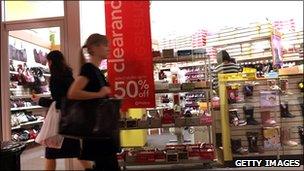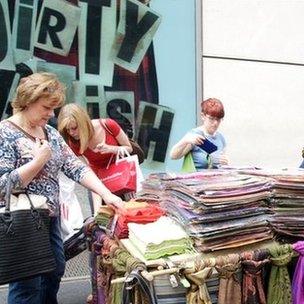Why has the US economy stalled?
- Published

Consumer spending virtually ground to a halt, meaning the US economy has, too
The US government has released its latest set of economic growth figures - which includes a set of revisions going back all the way to 2003.
The figures show that the recession - in 2008 and 2009 - was actually much worse than thought.
And on Friday, the Commerce Department said that second-quarter growth was much weaker than first thought, and revised the previous quarter down sharply - from 1.9% to 0.4%.
So just what it is holding back the US economy?
Deeper recession
One of the most telling facts of the set of revised figures is the new insight it gives into the extent of the recession.
"At the time, we were thinking that the numbers weren't as bad as what we seeing," says Carl Riccadonna, an economist at Deutsche Bank in New York.
"Now we know that the recession was deeper than we thought."
While the length of the recession - when the economy was shrinking - stayed the same, the contraction in real terms from the peak to the nadir was 5.1% - one percentage point more than thought.
Trillions were committed to bailing out the economy at the time - and the US economy is still in a hangover from the heady growth of the mid-2000's.
Consumers are key
The anaemic growth in the US economy is simply explained, according to Mr Riccadonna.
"It's the weakness in consumer spending," he says. "The numbers are picking up half as well as they normally do in a recovery."
Consumer spending accounts for 70% of the US economy.
Add to that, in a remarkable change in habits, people are saving more.
The savings rate has gone from zero at the height of the economic boom to about 6% now - which is billions of dollars being diverted from the economy and set aside.
With interest rates at record lows in the US, meaning that savers are getting little return, this illustrates how nervous US consumers are now of spending their money.
Especially on expensive one-offs, like a new house.
"You have all these longer-term problems, like a particularly poor labour market, very tight lending conditions and the housing market in a double-dip, with [property] prices still falling," says Paul Dales, an economist at Capital Economics.
In the second quarter, for example, personal consumption only rose at an annualised rate of 0.1% from the previous three months.
Proof of that is exports have remained strong.
Exports rose at an annualised rate of 6% in the second quarter. Last year, they rose 11.3% from 2009. So the weakness is due to Americans themselves.
'Chicken and egg'

Exports have surged, so the problems with the economy are down to domestic problems
Why? Perhaps because the number of jobless remains stubbornly high.
The US unemployment rate is 9.2% - and the US only added 18,000 jobs in June, the lowest in nine months.
Many economists consider unemployment the reason behind the underlying malaise in the economy.
"It becomes a chicken and egg situation," Mr Riccadonna says. "Businesses can't hire until consumers start spending, but people won't spend unless they're sure they have jobs."
Customers are therefore not making the big-ticket purchases - houses, cars and white goods such as fridges - that power strong growth.
A growth rate of 2% is considered the magic number, when an economy is cruising along.
The US grew by more than that in every quarter of last year. That seems to have suddenly ground to a halt this year.
Fear seems to have returned to US consumers, who are becoming even more reluctant to spend.
Solving that problem and getting people back into work will be the task of US politicians.
Unfortunately, with the president and Congress at an impasse over the US budget and debt ceiling, it seems the government is having trouble trying to fund itself.
"The chances of another recession are growing," says Mr Dales, "and a lot depends on what happens in Washington over the next few days."